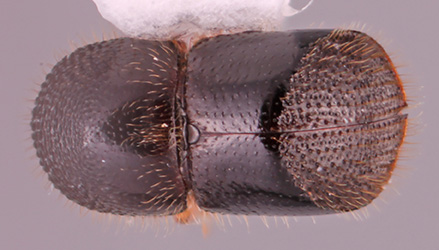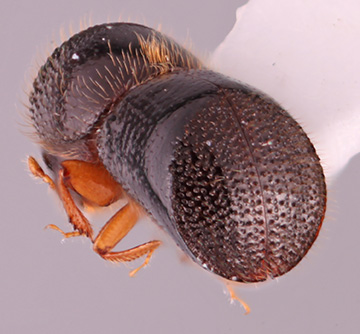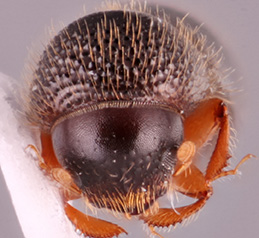Xylosandrus derupteterminatus
|
Xylosandrus derupteterminatus lateral; S.M. Smith |
|
Xylosandrus derupteterminatus dorsal; S.M. Smith |
|
Xylosandrus derupteterminatus declivity; S.M. Smith |
|
Xylosandrus derupteterminatus frontal; S.M. Smith |
Taxonomic history
Xyleborus derupteterminatus Schedl, 1951a: 64.
Xylosandrus derupteterminatus (Schedl): Schedl, 1964c: 213.
Diagnosis
2.0−2.3 mm long; 2.0 times as long as wide (Dole and Cognato 2010Dole and Cognato 2010:
Dole SA, Cognato AI, 2010. Revision of Xylosandrus Reitter (Curculionidae: Scolytinae). Proceedings of the California of Science 61: 451-545.). This species is distinguished by the small size; declivitydeclivity:
downward slope of either the pronotum or elytra
 obliquely truncatetruncate:
obliquely truncatetruncate:
appearing cut off or suddenly shortened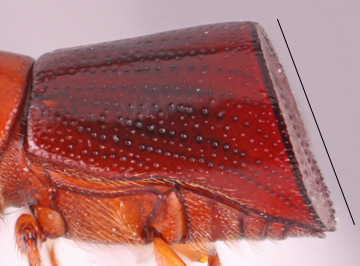 , abruptly separated from discdisc:
, abruptly separated from discdisc:
the flat central upper surface of any body part (e.g. pronotum and elytra) ; posterolateralposterolateral:
; posterolateralposterolateral:
'relating to end of the side part/portion
 margins of elytraelytron:
margins of elytraelytron:
'
the two sclerotized forewings of beetles that protect and cover the flight wings
carinate to interstriaeinterstria:
'longitudinal spaces along the elytra between the striae, which is not as<br />
impressed and bear smaller punctures.
 7; declivitaldeclivital:
7; declivitaldeclivital:
pertaining to the elytral declivity
face with five punctatepunctate:
'set with fine impressed points, appearing as pin pricks
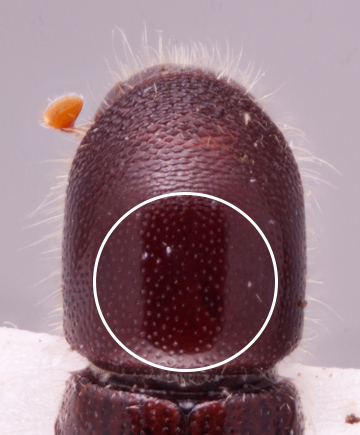 striae; declivitaldeclivital:
striae; declivitaldeclivital:
pertaining to the elytral declivity
interstriae densely uniseriate granulategranulate:
'pertaining to a coarse, grainy surface texture'
 ; pronotumpronotum:
; pronotumpronotum:
'the dorsal surface of the thorax
from dorsaldorsal:
'of or relating to the upper surface; opposite of ventral
 view rounded (type 1) and laterallateral:
view rounded (type 1) and laterallateral:
'pertaining to the side
 view basic (type 0), pronotalpronotal:
view basic (type 0), pronotalpronotal:
'pertaining to the pronotum
summit at midpoint, basalbase:
point or edge closest to the body; opposite of apex half smooth, shiningshining:
half smooth, shiningshining:
appearing glossy or bright in luster; referring to a surface that is polished and reflects light well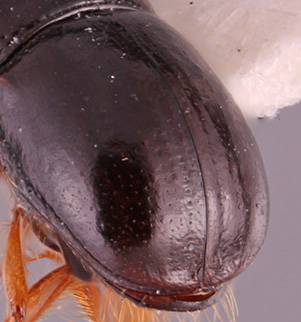 , sparsely minutely punctatepunctate:
, sparsely minutely punctatepunctate:
'set with fine impressed points, appearing as pin pricks
 ; and sparse mycangial tuftmycangial tuft:
; and sparse mycangial tuftmycangial tuft:
'tuft of setae that denotes the mycangia exterior opening
 on the pronotalpronotal:
on the pronotalpronotal:
'pertaining to the pronotum
basebase:
point or edge closest to the body; opposite of apex .
.
May be confused with
Xylosandrus adherescens, X. compactus, X. mesuae, and X. morigerus
Distribution
China (Yunnan), Indonesia (Java, Moluccas, Sulawesi), Laos, Thailand
Host plants
recorded only from Agathis (Araucariaceae) and Mangifera indica (Anacardiaceae) (Smith et al. 2020bSmith et al. 2020b:
Smith SM, Beaver RA, and Cognato AI. 2020b. A monograph of the Xyleborini (Coleoptera, Curculionidae, Scolytinae) of the Indochinese Peninsula (except Malaysia) and China. ZooKeys 983: 1-442. https://doi.org/10.3897/zookeys.983.52630)
DNA data
Sequences available for COI.
COI: MN620079


